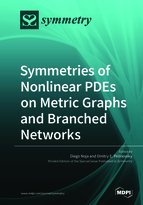Symmetries of Nonlinear PDEs on Metric Graphs and Branched Networks
A special issue of Symmetry (ISSN 2073-8994). This special issue belongs to the section "Mathematics".
Deadline for manuscript submissions: closed (15 January 2019) | Viewed by 17111
Special Issue Editors
Interests: singular perturbations of Schrödinger; wave and dirac equations and applications to various physical models; linear and nonlinear dispersive equations on singular structures and metric graphs; models of interaction between particles and classical fields
Special Issue Information
Dear Colleagues,
This Special Issue focuses on recent progress in a new area of mathematical physics and applied analysis, namely, on nonlinear partial differential equations on metric graphs and branched networks. This subject has seen many developments in the recent years. Graphs represent a system of edges connected at one or more branching points (vertices). The connection rule determines the graph topology. When the edges can be assigned a length and the wave functions on the edges are defined in metric spaces, the graph is called a metric graph.
Evolution equations on metric graphs have attracted much attention as effective tool for the modeling of particle and wave dynamics in branched structures and networks. Because the branched structures and networks appear in different areas of contemporary physics with many applications to electronics, biology, material science and nanotechnology, developing of effective modeling tools is important for many practical problems arising in these areas.
The list of important problems includes searches for standing waves, exploring of their properties (e.g., stability and asymptotic behavior), and scattering dynamics. This Special Issue will collect a representative sample of works devoted to solutions of these and other problems.
Prof. Diego Noja
Prof. Dmitry Pelinovsky
Guest Editor
Manuscript Submission Information
Manuscripts should be submitted online at www.mdpi.com by registering and logging in to this website. Once you are registered, click here to go to the submission form. Manuscripts can be submitted until the deadline. All submissions that pass pre-check are peer-reviewed. Accepted papers will be published continuously in the journal (as soon as accepted) and will be listed together on the special issue website. Research articles, review articles as well as short communications are invited. For planned papers, a title and short abstract (about 100 words) can be sent to the Editorial Office for announcement on this website.
Submitted manuscripts should not have been published previously, nor be under consideration for publication elsewhere (except conference proceedings papers). All manuscripts are thoroughly refereed through a single-blind peer-review process. A guide for authors and other relevant information for submission of manuscripts is available on the Instructions for Authors page. Symmetry is an international peer-reviewed open access monthly journal published by MDPI.
Please visit the Instructions for Authors page before submitting a manuscript. The Article Processing Charge (APC) for publication in this open access journal is 2400 CHF (Swiss Francs). Submitted papers should be well formatted and use good English. Authors may use MDPI's English editing service prior to publication or during author revisions.
Keywords
- Symmetries of partial differential equations
- Conserved quantities
- Spectral analysis on metric graphs
- Ground state
- Existence and stability of standing waves






